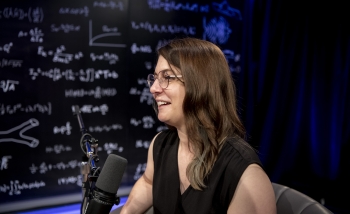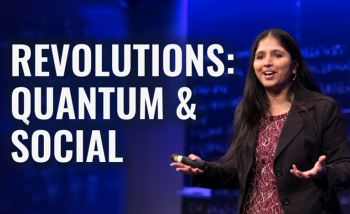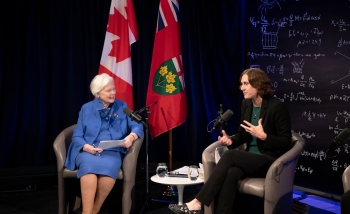Perimeter Associate Faculty member Theo Johnson-Freyd has been named an inaugural member of the newly established Simons Collaboration on Global Categorical Symmetries. The collaboration brings mathematicians and physicists together on a path toward deeper understanding of quantum field theory — the universal language of modern theoretical physics.
Directed by mathematical physicist Constantin Teleman at the University of California, Berkeley, the collaboration will focus on symmetry as a powerful tool for organizing physical phenomena and understanding the fundamental laws of nature.
Researchers have a long tradition of using symmetry to build bridges between mathematics and physics, notably including the work of mathematician Emmy Noether. In the early 20th century, Noether resolved some lingering gaps in Albert Einstein's still-new Theory of Relativity and revealed fundamental connections between the laws that govern the conservation of energy in a physical system, and symmetries in nature.
In the century of scientific progress since then, symmetry has remained a key part of how physicists have increased knowledge about the deep structures of physical reality — even though the symmetries researchers like Johnson-Freyd make use of work differently from the ones taught in introductory geometry classes.
“Many people are familiar with symmetries based on rotating or reflecting a shape. It's intuitive that when you rotate an object in a complete circle, or flip it and flip it back again, it returns to its original state,” Johnson-Freyd says. “But in quantum field theory, a complete rotation doesn’t necessarily take you back to where you began. I picture it like one of Escher’s infinite staircases: If you take a few steps, nothing much happens. But if you go all the way around to where you started, something very serious has happened.”
The Simons Collaboration builds on recent developments in quantum field theory, including new symmetry concepts that help explain many aspects of quantum field theory that exist at the nexus of observable phenomena and advanced mathematics.
“This is obviously not the first time that mathematicians and physicists have collaborated, but it’s a less common practice than it should be,” Johnson-Freyd says. “The Perimeter Institute and the Simons Center for Geometry and Physics both have notable histories of supporting this kind of cross-discipline cooperation. But even for those organizations, this collaboration offers an exceptionally high level of interconnectedness.”
While study in areas like quantum topology and noninvertible symmetries tends to happen deep in the realm of purely curiosity-driven research, Johnson-Freyd says practical by-products are almost inevitable.
“My collaborators are all amazing researchers,” says Johnson-Freyd. “I've worked with a few of them before, and others I only met through the grant application process. As we’ve gotten to know each other, we’ve discovered just how many common interests and questions we have. This is particularly cool because we all come at these questions with different tools and techniques.”
“Our work is likely to make a big impact on the study of topological phases of matter, which are key to the development of quantum materials and quantum computers,” he says. “We also expect our approach to contribute to the mass gap problem in quantum chromodynamics.”
The collaboration involves researchers from 17 institutions in seven countries, who officially begin working together in September 2021.
About PI
Perimeter Institute is the world’s largest research hub devoted to theoretical physics. The independent Institute was founded in 1999 to foster breakthroughs in the fundamental understanding of our universe, from the smallest particles to the entire cosmos. Research at Perimeter is motivated by the understanding that fundamental science advances human knowledge and catalyzes innovation, and that today’s theoretical physics is tomorrow’s technology. Located in the Region of Waterloo, the not-for-profit Institute is a unique public-private endeavour, including the Governments of Ontario and Canada, that enables cutting-edge research, trains the next generation of scientific pioneers, and shares the power of physics through award-winning educational outreach and public engagement.
You might be interested in




